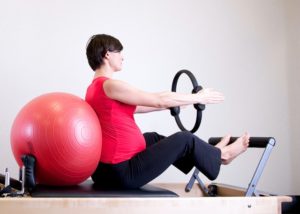“Do you need physical therapy while pregnant?” is a question many women ask when expectant. The answer to this question varies from person to person, and it depends on the individual’s situation. There are benefits and risks associated with prenatal physical therapy, but we will discuss that later. For now, let’s start by discussing what prenatal physical therapy entails.
What is Prenatal Physical Therapy?
Prenatal physical therapy is specialized fitness training that prepares women for an active lifestyle during pregnancy. Therapists can use this form of treatment to help mothers ease the pain and discomfort associated with pregnancy. Physical therapy for pregnant women also supports proper posture and strengthens muscles around joints (particularly in the pelvis). Prenatal physical therapy is an excellent choice to increase flexibility, improve balance and coordination skills, reduce stress on ligaments, and reduce back pain.
Physical therapists are specialized healthcare providers who have received training in the musculoskeletal system of the human body. These professionals offer alternative treatment through exercise, manual techniques (such as massage), and hydrotherapy (water-based exercises).
Benefits of Physical Therapy for Expectant Mothers
According to the American Pregnancy Association, physical therapy is a safe treatment option for pregnant women. The organization states that the benefits of prenatal physical therapy include:
1. Strengthening Pelvic Muscles
Prenatal physical therapy can help pregnant women strengthen their pelvic muscles. This is beneficial because the pelvis and its surrounding muscles support the weight of a growing baby. Also, when these muscles are strong enough to handle your child’s weight, they will be less prone to injury during delivery. Supporting the force requires significant strength.
Pelvic floor dysfunction can be common during pregnancy. Its characteristics include urinary urgency, frequency, urge incontinence, constipation, pelvic pain/pressure without a medical explanation, and sexual issues. Strengthening the pelvic muscles reduces stress on ligaments, which can lead to dysfunctions.
2. Improving Posture and Reducing Body Aches
The right physical therapy routine supports good posture during pregnancy. Swollen feet, varicose veins, hemorrhoids, backaches, or sciatica are all common among pregnant women. These issues occur when the body is not in proper alignment. A physical therapist can help you get to the correct position. Prenatal physical therapy strengthens muscles around joints to improve posture and reduce pain.
In addition, when your body is well-supported by strong muscles, it is less likely to cause injury when lifting heavy items or carrying your child. Physical therapy for pregnant women can also help reduce pain in the back, neck, and shoulders.
3. Prevention of Diastasis Recti Abdominis (DRA)
This condition occurs when your abdominal muscles separate during pregnancy. Excess pressure on the abdomen due to an expanding uterus causes the problem. The outcome of diastasis recti abdominis is poor trunk stability, pelvic instability, and lower back pain.
Working with a physical therapist may help you avoid developing this condition or reduce its severity during pregnancy. A prenatal program will strengthen the abdominal wall to prevent your muscles from splitting further apart if you already have DRA.
4. Reducing Weight Gain/Maintaining Fitness Level
Prenatal physical therapy helps expectant mothers gain less weight. You can maintain your fitness level even though you aren’t exercising as intensely during pregnancy. This is possible because the training prevents excess fat storage. Exercises prevent muscles from deteriorating due to disuse (since you’re not working out).
A physical therapist can help you safely get back into shape after giving birth. This helps reduce muscle pain, joint stiffness, and other aches that result from too much time between sessions (or no exercise at all).
5. Reducing stress on the Joints
 Expectant women often complain about aching joints during pregnancy. Physical therapy reduces stress and pain associated with these problems and strengthens muscles around the affected areas. This allows you to maintain or improve your flexibility, strength, and coordination levels.
Expectant women often complain about aching joints during pregnancy. Physical therapy reduces stress and pain associated with these problems and strengthens muscles around the affected areas. This allows you to maintain or improve your flexibility, strength, and coordination levels.
Joints are less likely to get injuries if weak muscles do not stress them. Thus, you can continue with your daily activities without fear of injury from overuse or tiredness. Prenatal physical therapy helps pregnant women avoid going into labor early due to overworked joints.
6. Fast Recovery after Birth
Having a baby is hard work. Pregnant women often need time to recover after giving birth. A great way to do this is through physical therapy sessions. It helps regain strength and reduce body aches after the delivery.
A physical therapist can also help you learn how to lift your child without properly compromising your spine or joints. Additionally, it speeds up recovery and reduces pain in these areas.
What to Do Before Physical Therapy While Expectant
The American College of Obstetricians & Gynecologists recommends exercise throughout pregnancy. However, it is essential to get a doctor’s assessment before you start any physical therapy program. The doctor will determine if the program is safe for you and your baby.
If it is, discuss with a physical therapist what kind of exercises are best during pregnancy. You collaborate to create an individualized plan that fits your needs and capabilities. You can also develop a series of home exercises to do before each session and on rest days.
Plan to schedule prenatal physical therapy at least once a week. This ensures you can get the most out of your sessions and make progress during pregnancy.
Physical Therapy Exercises to Avoid While Pregnant
You should not perform any exercises that require you to lie flat on your back. This position compresses the growing uterus and restricts blood flow from the baby (supine hypotensive syndrome). It is hazardous if done for over 20 minutes per session (or two hours a day).
A physical therapist will recommend other safe alternatives during this period. You can also avoid prenatal physical therapy exercises that require you to lie on your stomach. This position can compress the uterus, gastrointestinal tract, and bladder (which may cause cramping).
Avoid any exercise if it causes pain or discomfort during pregnancy. There are always safer alternatives available. You do not want to compromise your unborn baby’s well-being by exercising too intensely without physical therapist supervision.
Be aware of your body’s limitations during pregnancy and ask the physical therapist to modify exercises accordingly to avoid injury or stress on joints. This will allow for a safe, effective prenatal exercise program throughout pregnancy.
What Should You Expect During Prenatal Physical Therapy Sessions?
First, a physical therapist asks you about your pregnancy and medical history. They may also ask questions about any pain you are experiencing, location, and frequency. If necessary, the physical therapist can order lab tests to help pinpoint any issues causing problems during therapy sessions.
You can expect to focus mainly on exercises that strengthen your pelvic floor muscles (the uterus’ attachment site). There is also a series of therapeutic ultrasound treatments available to help improve blood flow and reduce pain. The ultrasound waves are painless and only take about 20 minutes for each session.
Your physical therapist can also help with stretching to reduce stress on the joints, ligaments, and tendons. A prenatal massage is an excellent way to relax after exercising each week if you have time. In addition, a physical therapist can recommend exercises to do at home every day before your next session.
If you are looking for a prenatal physical therapist near Dallas Area, OneRehab is the solution. We have a team of experienced physical therapists ready to serve you. Our objective is to educate and empower you throughout pregnancy. Through this, you can have an active, healthy pregnancy with the least complications.





